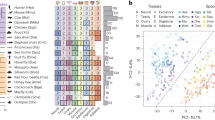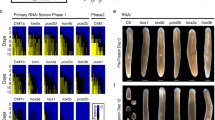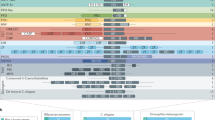Abstract
All insects possess homologous segments, but segment specification differs radically among insect orders. In Drosophila, maternal morphogens control the patterned activation of gap genes, which encode transcriptional regulators that shape the patterned expression of pair-rule genes. This patterning cascade takes place before cellularization. Pair-rule gene products subsequently ‘imprint’ segment polarity genes with reiterated patterns, thus defining the primordial segments. This mechanism must be greatly modified in insect groups in which many segments emerge only after cellularization1. In beetles and parasitic wasps, for instance, pair-rule homologues are expressed in patterns consistent with roles during segmentation, but these patterns emerge within cellular fields2,3,4. In contrast, although in locusts pair-rule homologues may not control segmentation5,6, some segment polarity genes and their interactions are conserved3,7,8,9,10. Perhaps segmentation is modular, with each module autonomously expressing a characteristic intrinsic behaviour in response to transient stimuli. If so, evolution could rearrange inputs to modules without changing their intrinsic behaviours. Here we suggest, using computer simulations, that the Drosophila segment polarity genes constitute such a module, and that this module is resistant to variations in the kinetic constants that govern its behaviour.
This is a preview of subscription content, access via your institution
Access options
Subscribe to this journal
Receive 51 print issues and online access
$199.00 per year
only $3.90 per issue
Buy this article
- Purchase on SpringerLink
- Instant access to full article PDF
Prices may be subject to local taxes which are calculated during checkout



Similar content being viewed by others
References
Patel, N. H. The evolution of arthropod segmentation: insights from comparisons of gene expression patterns. Dev. Suppl. 201– 207 (1994).
Brown, S. J., Hilgenfeld, R. B. & Denell, R. E. The beetle Tribolium castaneum has a fushi tarazu homolog expressed in stripes during segmentation. Proc. Natl Acad. Sci. USA 91, 12922–12926 (1994).
Grbic, M., Nagy, L. M., Carroll, S. B. & Strand, M. Polyembryonic development: insect pattern formation in a cellularized environment. Development 122, 795–804 (1996).
Brown, S. J., Parrish, J. K., Beeman, R. W. & Denell, R. E. Molecular characterization and embryonic expression of the even-skipped ortholog of Tribolium castaneum. Mech. Dev. 61, 165–173 (1997).
Patel, N. H., Ball, E. E. & Goodman, C. S. Changing role of even-skipped during the evolution of insect pattern formation. Nature 357, 339–342 (1992).
Dawes, R., Dawson, I., Falciani, F., Tear, G. & Akam, M. Dax, a locust Hox gene related to fushi-tarazu but showing no pair-rule expression. Development 120, 1561– 1572 (1994).
Patel, N. H., Kornberg, T. B. & Goodman, C. S. Expression of engrailed during segmentation in grasshopper and crayfish. Development 107, 201– 212 (1989).
Brown, S. J., Patel, N. H. & Denell, R. E. Embryonic expression of the single Tribolium engrailed homolog. Dev. Genet. 15, 7– 18 (1994).
Nagy, L. M. & Carroll, S. Conservation of wingless patterning functions in the short-germ embryos of Tribolium castaneum. Nature 367, 460–463 ( 1994).
Oppenheimer, D. I., MacNicol, A. M. & Patel, N. H. Functional conservation of the wingless-engrailed interaction as shown by a widely applicable baculovirus misexpression system. Curr. Biol. 9, 1288–1296 (1999).
Akam, M. The molecular basis for metameric pattern in the Drosophila embryo. Development 101, 1–22 (1987).
DiNardo, S., Sher, E., Heemskerk-Jongens, J., Kassis, J. A. & O'Farrell, P. H. Two-tiered regulation of spatially patterned engrailed gene expression during Drosophila embryogenesis. Nature 332, 604–609 (1988).
Ingham, P. W., Baker, N. E. & Martinez-Arias, A. Regulation of segment polarity genes in the Drosophila blastoderm by fushi tarazu and even skipped. Nature 331, 73–75 (1988).
Martinez Arias, A., Baker, N. E. & Ingham, P. W. Role of segment polarity genes in the definition and maintenance of cell states in the Drosophila embryo. Development 103, 157–170 (1988).
DiNardo, S., Heemskerk, J., Dougan, S. & O'Farrell, P. H. The making of a maggot: patterning the Drosophila embryonic epidermis. Curr. Opin. Genet. Dev. 4, 529– 534 (1994).
Hooper, J. E. Distinct pathways for autocrine and paracrine Wingless signalling in Drosophila embryos. Nature 372, 461– 464 (1994).
Aza-Blanc, P., Ramirez-Weber, F. A., Laget, M. P., Schwartz, C. & Kornberg, T. B. Proteolysis that is inhibited by hedgehog targets Cubitus interruptus protein to the nucleus and converts it to a repressor. Cell 89, 1043– 1053 (1997).
Kauffman, S. A. The Origins of Order: Self Organization and Selection in Evolution (Oxford Univ. Press, New York, 1993).
Sanchez, L, van Helden, J. & Thieffry, D. Establishment of the dorso-ventral pattern during embryonic development of drosophila melanogaster: a logical analysis. J. Theor. Biol. 189, 377–389 (1997).
Slack, J. M. W. From Egg to Embryo: Determinative Events in Early Development (Cambridge Univ. Press, New York, 1983).
Barkai, N. & Leibler, S. Robustness in simple biochemical networks. Nature 387, 913– 917 (1997).
Morton-Firth, C. J., Shimizu, T. S. & Bray, D. A free-energy-based stochastic simulation of the Tar receptor complex. J. Mol. Biol. 286, 1059 –1074 (1999).
Heemskerk, J., DiNardo, S., Kostriken, R. & O'Farrell, P. H. Multiple modes of engrailed regulation in the progression towards cell fate determination. Nature 352, 404– 410 (1991).
Vincent, J. P. & Lawrence, P. A. Drosophila wingless sustains engrailed expression only in adjoining cells: evidence from mosaic embryos. Cell 77, 909– 915 (1994).
Tabata, T., Eaton, S. & Kornberg, T. B. The Drosophila hedgehog gene is expressed specifically in posterior compartment cells and is a target of engrailed regulation. Genes Dev. 6, 2635–2645 (1992).
Schwartz, C., Locke, J., Nishida, C. & Kornberg, T. B. Analysis of cubitus interruptus regulation in Drosophila embryos and imaginal disks. Development 121, 1625– 1635 (1995).
Chen, Y. & Struhl, G. Dual roles for patched in sequestering and transducing Hedgehog. Cell 87, 553– 563 (1996).
Alexandre, C., Jacinto, A. & Ingham, P. W. Transcriptional activation of hedgehog target genes in Drosophila is mediated directly by the cubitus interruptus protein, a member of the GLI family of zinc finger DNA-binding proteins. Genes Dev. 10, 2003–2013 (1996).
Dominguez, M., Brunner, M., Hafen, E. & Basler, K. Sending and receiving the hedgehog signal: control by the Drosophila Gli protein Cubitus interruptus. Science 272, 1621– 1625 (1996).
Von Ohlen, T., Lessing, D., Nusse, R. & Hooper, J. E. Hedgehog signaling regulates transcription through cubitus interruptus, a sequence-specific DNA binding protein. Proc. Natl Acad. Sci. USA 94, 2404–2409 (1997).
Acknowledgements
We acknowledge encouragement and support from D. Nasser and the NSF. E.M. was supported by a HHMI predoctoral fellowship.
Author information
Authors and Affiliations
Corresponding author
Supplementary information
Rights and permissions
About this article
Cite this article
von Dassow, G., Meir, E., Munro, E. et al. The segment polarity network is a robust developmental module. Nature 406, 188–192 (2000). https://doi.org/10.1038/35018085
Received:
Accepted:
Issue Date:
DOI: https://doi.org/10.1038/35018085



